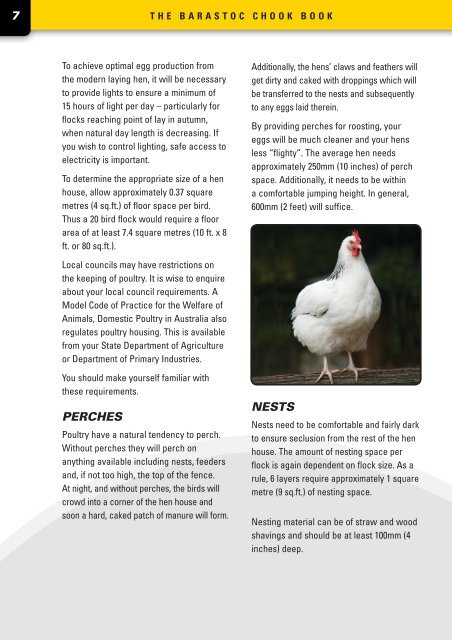THE CHOOK BOOK - Ridley Corporation
THE CHOOK BOOK - Ridley Corporation
THE CHOOK BOOK - Ridley Corporation
You also want an ePaper? Increase the reach of your titles
YUMPU automatically turns print PDFs into web optimized ePapers that Google loves.
7 <strong>THE</strong> BARASTOC <strong>CHOOK</strong> <strong>BOOK</strong> <strong>THE</strong> BARASTOC <strong>CHOOK</strong> <strong>BOOK</strong><br />
8<br />
To achieve optimal egg production from<br />
the modern laying hen, it will be necessary<br />
to provide lights to ensure a minimum of<br />
15 hours of light per day – particularly for<br />
flocks reaching point of lay in autumn,<br />
when natural day length is decreasing. If<br />
you wish to control lighting, safe access to<br />
electricity is important.<br />
To determine the appropriate size of a hen<br />
house, allow approximately 0.37 square<br />
metres (4 sq.ft.) of floor space per bird.<br />
Thus a 20 bird flock would require a floor<br />
area of at least 7.4 square metres (10 ft. x 8<br />
ft. or 80 sq.ft.).<br />
Local councils may have restrictions on<br />
the keeping of poultry. It is wise to enquire<br />
about your local council requirements. A<br />
Model Code of Practice for the Welfare of<br />
Animals, Domestic Poultry in Australia also<br />
regulates poultry housing. This is available<br />
from your State Department of Agriculture<br />
or Department of Primary Industries.<br />
You should make yourself familiar with<br />
these requirements.<br />
PERCHES<br />
Poultry have a natural tendency to perch.<br />
Without perches they will perch on<br />
anything available including nests, feeders<br />
and, if not too high, the top of the fence.<br />
At night, and without perches, the birds will<br />
crowd into a corner of the hen house and<br />
soon a hard, caked patch of manure will form.<br />
Additionally, the hens’ claws and feathers will<br />
get dirty and caked with droppings which will<br />
be transferred to the nests and subsequently<br />
to any eggs laid therein.<br />
By providing perches for roosting, your<br />
eggs will be much cleaner and your hens<br />
less “flighty”. The average hen needs<br />
approximately 250mm (10 inches) of perch<br />
space. Additionally, it needs to be within<br />
a comfortable jumping height. In general,<br />
600mm (2 feet) will suffice.<br />
NESTS<br />
Nests need to be comfortable and fairly dark<br />
to ensure seclusion from the rest of the hen<br />
house. The amount of nesting space per<br />
flock is again dependent on flock size. As a<br />
rule, 6 layers require approximately 1 square<br />
metre (9 sq.ft.) of nesting space.<br />
Nesting material can be of straw and wood<br />
shavings and should be at least 100mm (4<br />
inches) deep.<br />
Shallow nests cause fighting and<br />
encourage feather picking and cannibalism.<br />
Keep nests clean to avoid soiling the eggs.<br />
Hens can be trained not to sleep in nests by<br />
providing perches and excluding them from<br />
the nests in the evening. This will also reduce<br />
the incidence of broodiness amongst the<br />
hens. Reopen the nest when they are asleep<br />
and after a week or two the birds will have<br />
formed a roosting habit, greatly reducing the<br />
amount of droppings in the nests.<br />
Collect eggs twice a day to ensure freshness<br />
and minimise the opportunity for egg eating.<br />
HEALTH<br />
Maintaining a productive and healthy flock<br />
must be the main objective of every poultry<br />
keeper. With proper management, the<br />
incidence of disease and other problems is<br />
lessened.<br />
COCCIDIOSIS<br />
Coccidiosis is caused by an intestinal<br />
parasite. It generally occurs because of<br />
damp ground or litter in the hen house<br />
which encourages the survival and<br />
maturation of the oocyst – the infectious<br />
stage of the coccidiosis life cycle.<br />
There are two main types: Caecal Coccidiosis<br />
usually affects young pullets up to 8 weeks of<br />
age and Intestinal Coccidiosis is more likely<br />
to occur in pullets from 8 to 12 weeks of age.<br />
Both types of coccidiosis can cause significant<br />
mortalities and chronic ill thrift in a percentage<br />
of the survivors, and hence a loss of flock<br />
uniformity. Signs that pullets are affected<br />
by clinical coccidiosis include mortalities,<br />
huddling, ruffled feathers, depression and<br />
blood in the droppings (faeces).<br />
Losses can be significant unless the<br />
affected birds are treated appropriately.<br />
Because there are a number of different<br />
species of poultry coccidia, pullets can<br />
experience repeated cases of coccidiosis<br />
under poor husbandry conditions.<br />
Beyond point of lay, birds will generally<br />
have developed an immunity to coccidia.<br />
Given the prevalence of coccidiosis,<br />
an anticoccidial feed additive has been<br />
included in Barastoc Pullet Starter and<br />
Barastoc Pullet Grower to help protect<br />
young birds when they’re most vulnerable.<br />
If further control measures are required,<br />
be sure to seek advice from a veterinarian and<br />
always ensure that any additional medications<br />
are compatible with in-feed additives.<br />
WORMS<br />
The large roundworm (Ascaridia spp.) is the<br />
most likely to cause trouble in the backyard<br />
or free range flock. The adult worm lives in<br />
the intestine where it lays large numbers


